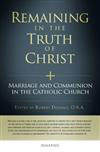
FGF E-Package
The Confederate Lawyer
November 7, 2014

Remaining in the Truth of Christ:
A Book Review
by Charles G. Mills
fitzgerald griffin foundation
GLEN COVE, NY — Remaining in the Truth of Christ: Marriage and Communion in the Catholic Church edited by Robert Dodaro, O.S.A., (Ignatius Press, 2014, 304 pages) is a collection of nine essays about Catholics who divorce and remarry. Five essays are authored by Cardinals; two are by Jesuits.
This book has something for everyone. Some essays provide the results of sophisticated scholarship for readers interested in such analyses. Others may be enlightening to less sophisticated readers.
The essays ... argue for the rejection of Cardinal Kaspar’s argument for some kind of readmission of some who have remarried to the Eucharist without amendment of their lives.
My favorite essay is “Dominical Teaching on Divorce and Remarriage” by Paul Mankowski, S. J. It includes a thorough examination of each New Testament quotation or paraphrase of Our Lord on the subject of divorce. This is one of several essays that requite an understanding of Jewish law, particularly the distinction between the law given to all humanity through Noah and the law given to the Jews through Moses.
This and several other essays point out that the Pharisees of Our Lord’s time wanted to discuss with Jesus their questions about when divorce is allowed. Jesus, instead, in his role as supreme legislator, reinstated the old law of Noah (or perhaps of Adam) prohibiting all divorce. This reinstatement can be found in the Gospels of Matthew, Mark, Luke, and in the first letter of Saint Paul to the Corinthians.
Father Mankowski notes that the exception to the prohibition of divorce in Matthew 5:32 (sometimes numbered as 5:33) is usually translated as something like, “But I say to you whoever shall put away his wife except in the case of fornication makes her commit adultery [or unchastity], and he that shall marry her that is divorced commits adultery.”
Jesus, in his role as supreme legislator, reinstated the old law of Noah (or perhaps of Adam) prohibiting all divorce.
He maintains that the text should actually be translated as “incest” instead of “fornication” or “unchastity.” I wish the editors had printed the Greek and Hebrew texts in Father Mankowsi’s essay in Greek and Hebrew characters instead of awkward Latin ones.
Another important essay is authored by Cardinal Raymond Burke. It is a clear and detailed explanation of how the marriage case jurisprudence of the Church is supposed to work. It is also a plea for truth in legal proceedings and a rejection of the curse of legal positivism.
“Separation, Divorce, Dissolution of the Bond, and Remarriage: Theological and Practical Approaches of the Orthodox Churches” by Archbishop Cyril Vasil, S. J., is a meticulous and scholarly study. He details the accommodation that Orthodox churches extended with respect to divorce and the gradual creation of chaos that resulted from different rules in different parts of the world.
Before the Great Schism, the Church in the East lived in an uneasy truce with emperors, including Justinian, who allowed divorce in certain cases. In 692, one Eastern Council recognized the right of the wives of soldiers missing in action to remarry. By the year 920, at least one Eastern Patriarchate recognized the civil law grounds for divorce.
Cardinal Raymond Burke [provides]... a clear and detailed explanation of how the marriage case jurisprudence of the Church is supposed to work.
After the Great Schism, the willingness of the Orthodox to accommodate divorce worsened. All Orthodox churches agree on the permissibility of divorce in cases of adultery. Generally, the Orthodox do not require a purpose of amendment of life before the remarried can be allowed to receive the Eucharist.
A primary purpose of many of the essays is to argue for the rejection of Cardinal Kaspar’s argument for some kind of readmission of some who have remarried to the Eucharist without amendment of their lives. Such amendment includes a firm purpose not to have conjugal relations with their second spouse until validly married to that person.
Cardinal Walter Brandmuller narrates the heroism of the Church in the West in opposing the demands of the powerful for divorce, precisely when the Church in the East, except for pockets of Catholicism, was giving in on this issue.
Cardinals Gerhard Müller, Carlo Caffarra, and Velasio de Paolis, offer persuasive arguments against allowing invalidly remarried persons to receive the Eucharist.
Saint John Paul II is frequently quoted in this book.
Remaining in the Truth of Christ will equip readers to argue effectively against Cardinal Kaspar’s proposal from theological, biblical, philosophical, historical, and legal points of view.
The Confederate Lawyer archives
The Confederate Lawyer column is copyright © 2014 by Charles G. Mills and the Fitzgerald Griffin Foundation, www.fgfBooks.com. All rights reserved.
This column may be forwarded, posted, or published if credit is given to Charles Mills and fgfBooks.com.
Charles G. Mills is the Judge Advocate or general counsel for the New York State American Legion. He has forty years of experience in many trial and appellate courts and has published several articles about the law.
See his biographical sketch and additional columns here.
To sponsor the FGF E-Package, please send a tax-deductible donation to the:
Fitzgerald Griffin Foundation
344 Maple Avenue West, #281
Vienna, VA 22180
1-877-726-0058
publishing@fgfbooks.com
or donate online.
@ 2025 Fitzgerald Griffin Foundation